Page 85 of 224
Weight group Child restraint system Type of child restraint system Child restraint system installationGroup1–from9upto
18 kg
Fair G0/1S ISOFIX
Approval number: E4 04443718
Fiat order code for Central and
Southern Europe: 71806647
Fiat order code for Northern
Europe: 71806649
Fiat order code for Eastern
Europe: 71806650
It must be fitted rearward facing using the Isofix
platform "L" type, specific for 500L, the car's
Isofix anchorages and the recommended CRS
head restraint shown on the left.
It must be fitted in the rear outer seats. Adjust
the rear seat as far forward as the position of the
front seat allows. ++Fair ISOFIX RWF platform,
"L" type for G0/1S
Fiat order code: 71806634
++Fair head restraint
Fiat order code for Central and
Southern Europe: 71806648
Fiat order code for Northern
Europe: 71806652
Fiat order code for Eastern
Europe: 71806653
83
9-1-2015 12:9 Pagina 83
Page 86 of 224
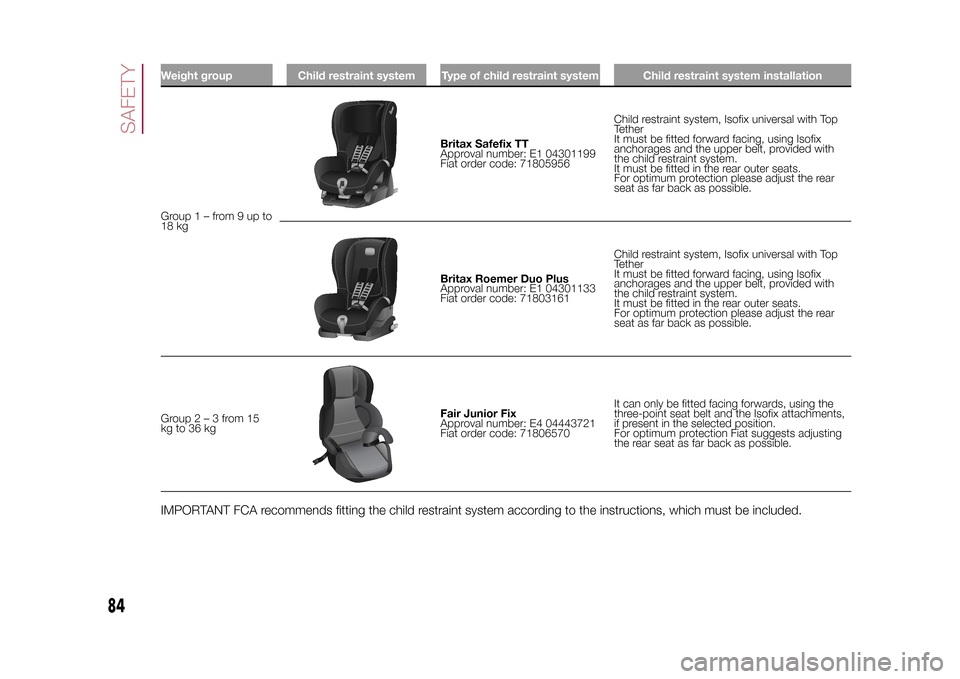
Weight group Child restraint system Type of child restraint system Child restraint system installationGroup1–from9upto
18 kg
Britax Safefix TT
Approval number: E1 04301199
Fiat order code: 71805956Child restraint system, Isofix universal with Top
Tether
It must be fitted forward facing, using Isofix
anchorages and the upper belt, provided with
the child restraint system.
It must be fitted in the rear outer seats.
For optimum protection please adjust the rear
seat as far back as possible.Britax Roemer Duo Plus
Approval number: E1 04301133
Fiat order code: 71803161Child restraint system, Isofix universal with Top
Tether
It must be fitted forward facing, using Isofix
anchorages and the upper belt, provided with
the child restraint system.
It must be fitted in the rear outer seats.
For optimum protection please adjust the rear
seat as far back as possible.
Group2–3from15
kg to 36 kgFair Junior Fix
Approval number: E4 04443721
Fiat order code: 71806570It can only be fitted facing forwards, using the
three-point seat belt and the Isofix attachments,
if present in the selected position.
For optimum protection Fiat suggests adjusting
the rear seat as far back as possible.
IMPORTANT FCA recommends fitting the child restraint system according to the instructions, which must be included.
84
SAFETY
9-1-2015 12:9 Pagina 84
Page 106 of 224
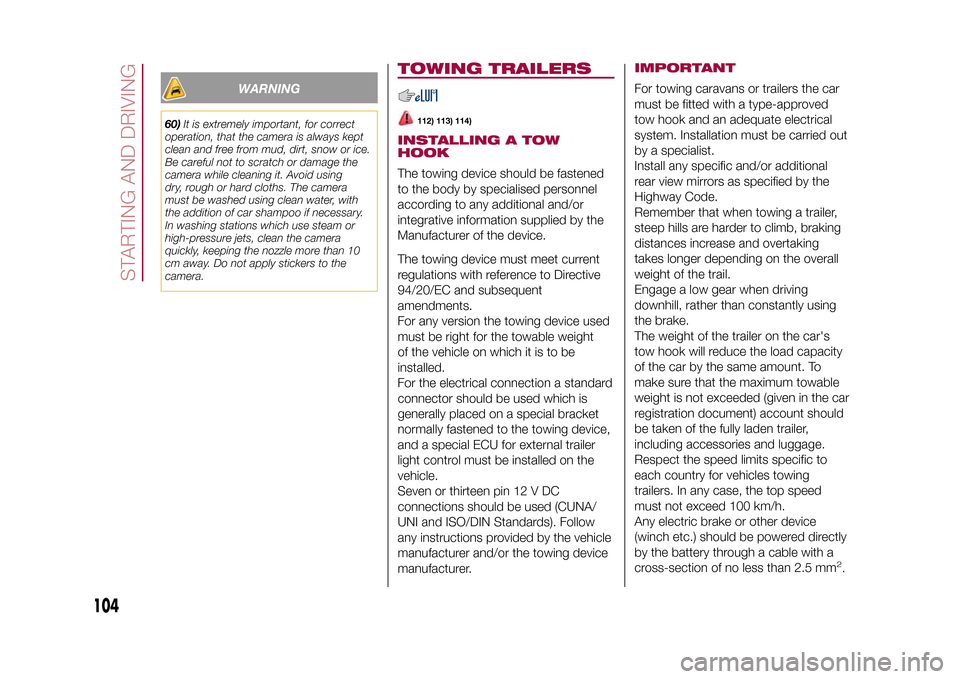
WARNING
60)It is extremely important, for correct
operation, that the camera is always kept
clean and free from mud, dirt, snow or ice.
Be careful not to scratch or damage the
camera while cleaning it. Avoid using
dry, rough or hard cloths. The camera
must be washed using clean water, with
the addition of car shampoo if necessary.
In washing stations which use steam or
high-pressure jets, clean the camera
quickly, keeping the nozzle more than 10
cm away. Do not apply stickers to the
camera.
TOWING TRAILERS
112) 113) 114)
INSTALLING A TOW
HOOKThe towing device should be fastened
to the body by specialised personnel
according to any additional and/or
integrative information supplied by the
Manufacturer of the device.
The towing device must meet current
regulations with reference to Directive
94/20/EC and subsequent
amendments.
For any version the towing device used
must be right for the towable weight
of the vehicle on which it is to be
installed.
For the electrical connection a standard
connector should be used which is
generally placed on a special bracket
normally fastened to the towing device,
and a special ECU for external trailer
light control must be installed on the
vehicle.
Seven or thirteen pin 12 V DC
connections should be used (CUNA/
UNI and ISO/DIN Standards). Follow
any instructions provided by the vehicle
manufacturer and/or the towing device
manufacturer.
IMPORTANTFor towing caravans or trailers the car
must be fitted with a type-approved
tow hook and an adequate electrical
system. Installation must be carried out
by a specialist.
Install any specific and/or additional
rear view mirrors as specified by the
Highway Code.
Remember that when towing a trailer,
steep hills are harder to climb, braking
distances increase and overtaking
takes longer depending on the overall
weight of the trail.
Engage a low gear when driving
downhill, rather than constantly using
the brake.
The weight of the trailer on the car's
tow hook will reduce the load capacity
of the car by the same amount. To
make sure that the maximum towable
weight is not exceeded (given in the car
registration document) account should
be taken of the fully laden trailer,
including accessories and luggage.
Respect the speed limits specific to
each country for vehicles towing
trailers. In any case, the top speed
must not exceed 100 km/h.
Any electric brake or other device
(winch etc.) should be powered directly
by the battery through a cable with a
cross-section of no less than 2.5 mm
2.
104
STARTING AND DRIVING
9-1-2015 12:9 Pagina 104
Page 111 of 224
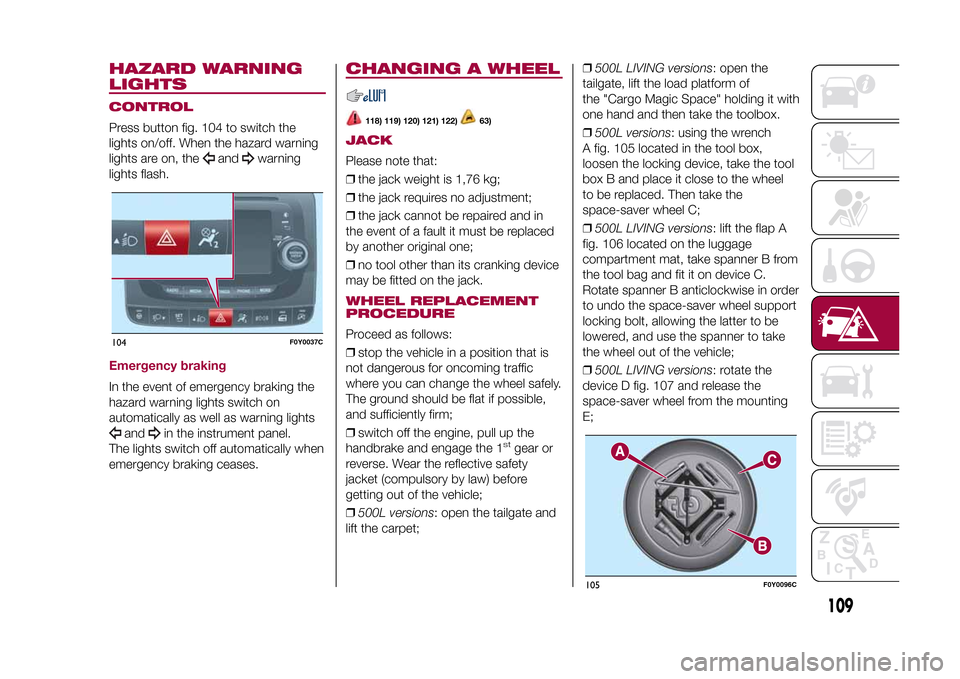
HAZARD WARNING
LIGHTSCONTROLPress button fig. 104 to switch the
lights on/off. When the hazard warning
lights are on, the
and
warning
lights flash.
Emergency brakingIn the event of emergency braking the
hazard warning lights switch on
automatically as well as warning lights
and
in the instrument panel.
The lights switch off automatically when
emergency braking ceases.
CHANGING A WHEEL
118) 119) 120) 121) 122)
63)
JACKPlease note that:
❒the jack weight is 1,76 kg;
❒the jack requires no adjustment;
❒the jack cannot be repaired and in
the event of a fault it must be replaced
by another original one;
❒no tool other than its cranking device
may be fitted on the jack.WHEEL REPLACEMENT
PROCEDUREProceed as follows:
❒stop the vehicle in a position that is
not dangerous for oncoming traffic
where you can change the wheel safely.
The ground should be flat if possible,
and sufficiently firm;
❒switch off the engine, pull up the
handbrake and engage the 1
stgear or
reverse. Wear the reflective safety
jacket (compulsory by law) before
getting out of the vehicle;
❒500L versions: open the tailgate and
lift the carpet;❒500L LIVING versions: open the
tailgate, lift the load platform of
the "Cargo Magic Space" holding it with
one hand and then take the toolbox.
❒500L versions: using the wrench
A fig. 105 located in the tool box,
loosen the locking device, take the tool
box B and place it close to the wheel
to be replaced. Then take the
space-saver wheel C;
❒500L LIVING versions: lift the flap A
fig. 106 located on the luggage
compartment mat, take spanner B from
the tool bag and fit it on device C.
Rotate spanner B anticlockwise in order
to undo the space-saver wheel support
locking bolt, allowing the latter to be
lowered, and use the spanner to take
the wheel out of the vehicle;
❒500L LIVING versions: rotate the
device D fig. 107 and release the
space-saver wheel from the mounting
E;
104
F0Y0037C
105
F0Y0096C
109
9-1-2015 12:9 Pagina 109
Page 161 of 224
TECHNICAL SPECIFICATIONS
Everything you may find useful for
understanding how your vehicle
is made and works is contained in this
chapter and illustrated with data, tables
and graphics. For the enthusiasts and
the technician, but also just for those
who want to know every detail of their
vehicle.IDENTIFICATION DATA....................160
ENGINE ..........................................161
WHEELS .........................................164
DIMENSIONS ..................................170
PERFORMANCE .............................173
WEIGHTS........................................175
SUPPLIES .......................................181
FLUIDS AND LUBRICANTS ............183
FUEL CONSUMPTION ....................186
CO2 EMISSIONS ............................189
PRESCRIPTIONS FOR HANDLING
THE VEHICLE AT THE END OF ITS
LIFE ................................................192
159
9-1-2015 12:9 Pagina 159
Page 162 of 224
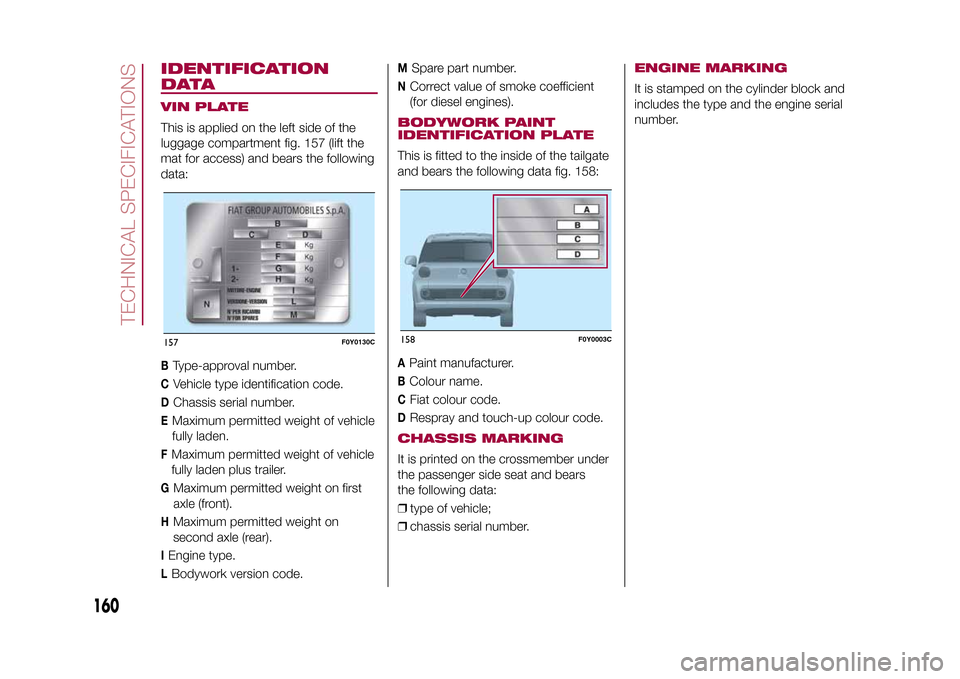
IDENTIFICATION
DATAVIN PLATEThis is applied on the left side of the
luggage compartment fig. 157 (lift the
mat for access) and bears the following
data:B
Type-approval number.
C
Vehicle type identification code.
D
Chassis serial number.
EMaximum permitted weight of vehicle
fully laden.FMaximum permitted weight of vehicle
fully laden plus trailer.G
Maximum permitted weight on first
axle (front).
H
Maximum permitted weight on
second axle (rear).
IEngine type.LBodywork version code.
M
Spare part number.
N
Correct value of smoke coefficient
(for diesel engines).
BODYWORK PAINT
IDENTIFICATION PLATEThis is fitted to the inside of the tailgate
and bears the following data fig. 158:A
Paint manufacturer.
B
Colour name.
C
Fiat colour code.
D
Respray and touch-up colour code.
CHASSIS MARKINGIt is printed on the crossmember under
the passenger side seat and bears
the following data:
❒type of vehicle;
❒chassis serial number.
ENGINE MARKINGIt is stamped on the cylinder block and
includes the type and the engine serial
number.
157
F0Y0130C
158
F0Y0003C
160
TECHNICAL SPECIFICATIONS
9-1-2015 12:9 Pagina 160
Page 177 of 224
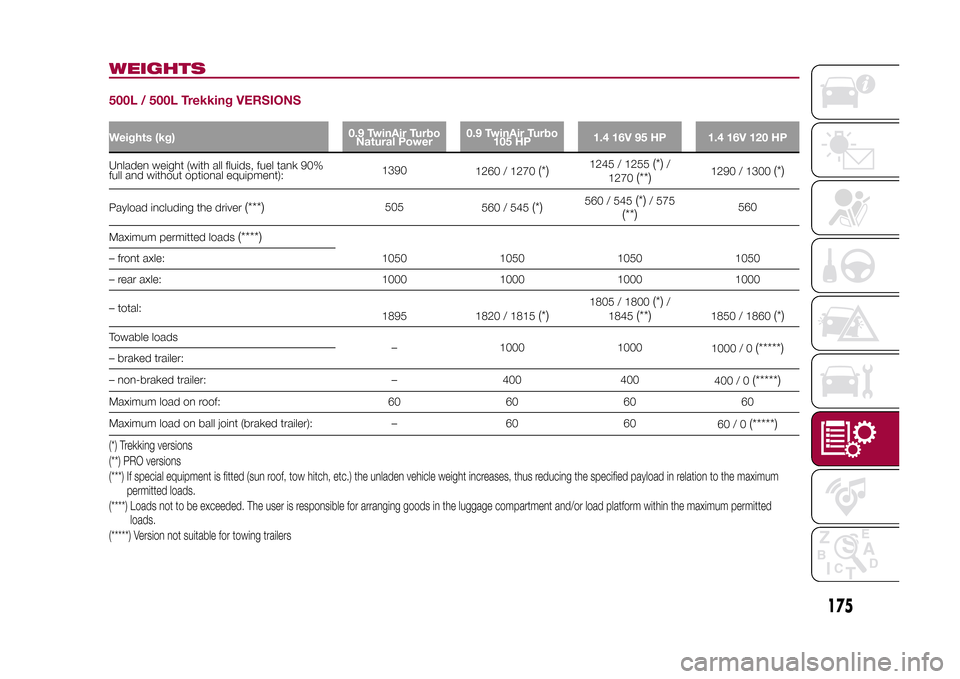
WEIGHTS500L / 500L Trekking VERSIONSWeights (kg)0.9 TwinAir Turbo
Natural Power0.9 TwinAir Turbo
105 HP1.4 16V 95 HP 1.4 16V 120 HPUnladen weight (with all fluids, fuel tank 90%
full and without optional equipment):1390
1260 / 1270
(*)
1245 / 1255
(*)
/
1270
(**)
1290 / 1300
(*)
Payload including the driver
(***)
505
560 / 545
(*)
560 / 545
(*)
/ 575
(**)
560
Maximum permitted loads
(****)
1050 1050 1050 1050 – front axle:
– rear axle: 1000 1000 1000 1000
– total:
1895 1820 / 1815
(*)
1805 / 1800
(*)
/
1845
(**)
1850 / 1860
(*)
Towable loads
– 1000 1000
1000 / 0
(*****)
– braked trailer:
– non-braked trailer: – 400 400
400/0
(*****)
Maximum load on roof: 60 60 60 60
Maximum load on ball joint (braked trailer): – 60 60
60/0
(*****)
(*) Trekking versions
(**) PRO versions
(***) If special equipment is fitted (sun roof, tow hitch, etc.) the unladen vehicle weight increases, thus reducing the specified payload in relation to the maximum
permitted loads.
(****) Loads not to be exceeded. The user is responsible for arranging goods in the luggage compartment and/or load platform within the maximum permitted
loads.
(*****) Version not suitable for towing trailers
175
9-1-2015 12:9 Pagina 175
Page 178 of 224
Weights (kg) 1.4 16V 120 HP LPG 1.3 16V MultiJet 1.3 16V MultiJet DualogicUnladen weight (with all fluids, fuel tank 90%
full and without optional equipment):1310 / 1320
(*)
1295 / 1305
(*)
/ 1320
(**)
1300 / 1310
(*)
Payload including the driver
(***)
560
550 / 545
(*)
/ 575
(**)
560 / 545
(*)
Maximum permitted loads
(****)
1050 1050 1050 – front axle:
– rear axle: 1000 1000 1000
– total:
1870 / 1880
(*)
1845 / 1850
(*)
/ 1895
(**)
1850 / 1855
(*)
Towable loads
1000 / 0
(****)
1000 1000
– braked trailer:
– non-braked trailer:
400/0
(****)
400 400
Maximum load on roof: 60 60 60
Maximum load on ball joint (braked trailer):
60/0
(****)
60 60
(*) Trekking versions
(**) PRO versions
(***) If special equipment is fitted (sun roof, tow hitch, etc.) the unladen vehicle weight increases, thus reducing the specified payload in relation to the maximum
permitted loads.
(****) Version not suitable for towing trailers
176
TECHNICAL SPECIFICATIONS
9-1-2015 12:9 Pagina 176